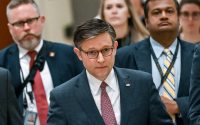Germany Introduces Its First National Security Strategy
BERLIN — Germany unveiled its first comprehensive national security strategy on Wednesday, an effort to address Germany’s priorities and ambitions in a Europe transformed by Russia’s invasion of Ukraine.
The strategy was announced as part of the new government’s coalition agreement when Chancellor Olaf Scholz took office in December 2021. But the war in Ukraine has since heightened Germany’s sense that it had become vulnerable to new military, economic and geopolitical threats, including climate change.
“Germany’s security environment is undergoing profound change and we are living through a watershed era, a Zeitenwende,” or turning point, the paper says. With Russia’s threat to European security, and China seen as a complicated competitor, systemic rival but still “a necessary partner,” the paper says, “we are redoubling our efforts with a view to keeping our country secure and free.”
Mr. Scholz praised the paper’s effort to combine foreign, domestic and economic priorities, calling it “a big, big change in the way we deal with security issues.” But while the publication of the document was largely welcomed, some analysts said it lacked detail, especially on how its ambitions would be funded.
In general, the strategy focuses on three pillars of German security. First, an active, “robust” defense, including a new strategic culture, commitments to high military spending, including reaching the NATO goal of 2 percent of gross domestic product from next year, and a concentration on deterrence, not disarmament.
Second is resilience — the ability of Germany and its allies to protect their values, to reduce economic dependencies on rivals, to deter and defeat cyberattacks and to defend the United Nations Charter and the rule of law.
Third is sustainability, a pillar that includes issues like climate change and the energy and food crises.
The document got relatively positive reviews from analysts as a statement of how far Germany has come in changing its strategic culture since Russia launched its full-scale invasion of Ukraine in February 2022, but some questioned whether the ministries of a rivalrous coalition government will carry through the document’s ambitions, especially given the lack of financial commitments.
“To call it a status quo document sounds unfair, but it does try to take stock of where we stand now, and it’s already an achievement to say how far Germany has come,” said Claudia Major of the German Institute for International and Security Affairs.
Strategies are expected to connect means and ends, she said. “But to a certain extent this strategy is not able to do that, because it’s not linked to clear budget consequences,” she said.
Christian Lindner, the country’s finance minister and head of the Free Democrats, acknowledged Wednesday that new commitments proposed in the strategy — notably the 2 percent spending on defense — would require new financing, but he was unable to give projections on the cost.
The strategy has been long delayed because of coalition infighting — including an agreement to drop the idea of a German national security council altogether. China has been such a contentious issue that it will be dealt with in a separate paper scheduled to be published next month.
“It’s hard to be ambitious with so many cooks,” said Ulrich Speck, a German analyst. The vagueness in the document about how Germany intends to meet its ambitions is deliberate, he suggested, a way for Mr. Scholz, a Social Democrat, to keep freedom of action on the big issues of foreign policy inside the chancellery and not cede them to the foreign ministry and Ms. Baerbock, a Green.
Norbert Röttgen, an opposition legislator from the Christian Democratic Union and a foreign-policy expert, was sharply critical of the document, which he called “the lowest common denominator” of a divided coalition government, “a description of the undisputed part of the status quo” and “essentially without strategy.”


